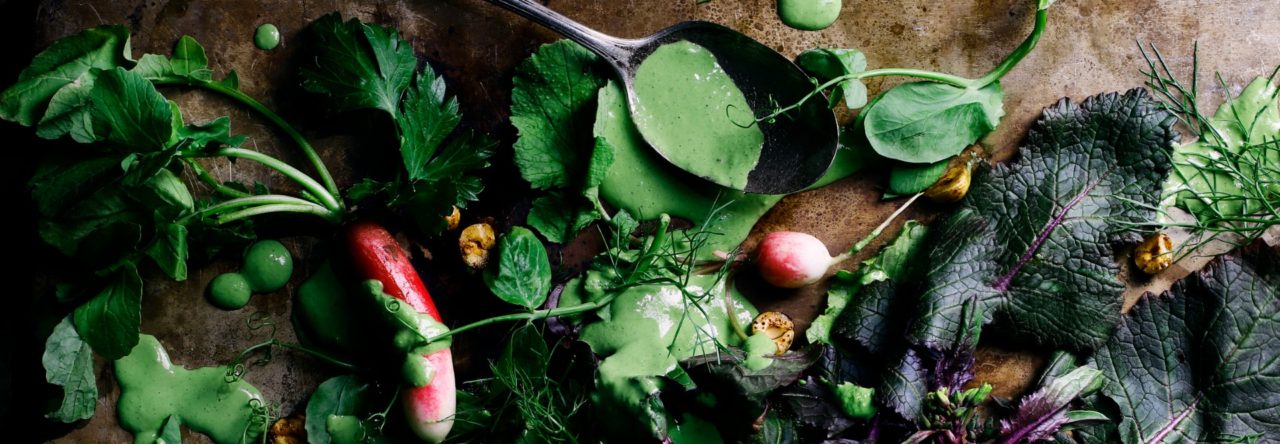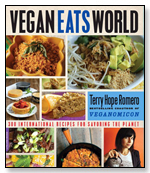 Tis’ the season and yet again I’ve spaced on Christmas food.
Tis’ the season and yet again I’ve spaced on Christmas food.
The quest for the perfect vegan fruitcake didn’t happen and I’ve avoided most cookie making. I’ve eaten only one candy cane and didn’t even lift a carton of soy nog. But last night I went all in for down-to-the-twine tamale making, for perhaps one of the most labor intensive of them: hallacas (AH-yah-kahs), the traditional Venezuelan Christmas tamale. As I took the first bite of hallaca in what had to be well over a decade I had to stop, put the plate down, call my parents and tell them the impossible had been done; not only are these vegan, but I made them all by myself. For anyone that’s ever made tamales for the first time without a team of tamale assistants feels like you just ran the marathon with corn (or plantain) leaves on your feet, no small accomplishment.
I’d like to think that among the millions of Venezuelan cooks making hallacas tonight and over the next few weeks there are a few inspired chefs making meatless ones too. In the realm of recipe veganization this was a logical translation, considering the excellent seitan and vegetable broth options existing in vegan grocery land. When I offered up my recipe to my parents they thought I went overboard with the lavish ingredients (all those spices, so many vegetables) but really, if you’re going to spend half a day fussing with plantain leaves and tying bundles of twine why not go the extra inch or three? The most annoying part of any tamale making is the actually assembly itself, but with a little time and extra counter space it’s no different than frosting a few dozen of cupcakes or making a big batch of stuffing.
So what exactly is an hallaca? If you’re familiar with most Mexican-style tamales then these may look a different from what you’re used to but the concept is the same: a seasoned corn dough folded over moist filling that’s wrapped in leaves (here swaths of green plantain leaves), tied up and steamed. Well, traditional hallacas are boiled but I found steaming to be faster and neater. And what does an hallaca taste like? The cooked dough is dense and moist, not unlike a firm polenta. It’s tinted neon yellow-orange from the tropical seed annatto, used in this country commercially for tinting cheese and packaged foods but can be purchased for pennies at any ethnic grocery store. The filling is composed of a stew-like sauce called a “guiso” (GHEE-so), flavored with mellow vegetables and a sweet & tangy finish from wine and vinegar. There’s typically meat in the stew and here seitan comes to the rescue, but chopped mushrooms would be equally toothsome. So-called garnishes (really just more filling) are placed on top of the guiso stew before the dough is folded on top: typical meatless additions include olives, raisins, capers or almonds.
The plantain leaf wrapping is the hallmark of the hallaca, but in a pinch parchment paper or corn husks can be used. However they lack that subtle herbal/grassy aroma that the plantain leaves infuse into the hallacas. Look for frozen plantain leaves sold in 1 lb. packages in ethnic groceries. The ones I purchased are from Thailand, so be sure to explore Asian groceries for this crazy ingredient. You could get away with one pound of leaves for this recipe but I found it’s worth having that extra pound; these leaves are natural products and can irregularities that can make one a little crazy when trying to find the perfect leaf for wrapping an hallaca.
Will you be making hallacas tonight? Hallacas are a little unusual for the uninitiated, but tamale afficianados should take note. If you are just that kind of tamale adventure seeker, here’s a few tips:
• Make the guiso up to two days in advance. Trim plantain leaves to desired size and tightly wrap a few days ahead too.
• Extra workspace for tamales helps a bundle. Borrow a folding table and set up an extra work station, it’s helpful when unfolding huge plantain leaves.
• Assembled, uncooked hallacas can be stored in the fridge (in a tightly covered container) for three days. Reheat cooked tamales by re-steaming for 10-12 minutes or wrap in moist paper towels and microwave on high for about 3 minutes until center is hot.
• Try this speedy trick with the tamale dough: tightly fit a plastic bag over a small cutting board or dinner plate. Firmly and evenly press on top of the dough (that’s on top of the oiled leaf) and squish it around to flatten the dough to a 1/4 inch thick circle. It’s much faster than patting out the dough with your fingers.
• You’ll need about 1 1/2 lbs of masarepa flour, about 1 1/2 small bags.
• Annatto oil will stain everything it touches bright orange, so opt for old kitchen towels and save the vintage white lace tea towels for another day. 
For more epic photojournalism of hallaca assembly, check out my Veganlatina Flickr set.
Hallacas Veganas
makes 18 large tamales
For assembling hallacas
Two 1lb packages frozen plantain leaves
kitchen twine for tying
Richly Flavored Stew (guiso)
3 tablespoons olive oil
8 oz seitan, diced into thin 1/4 thick pieces
2 cloves garlic, chopped
1 green bell pepper, diced small
2 tablespoons red wine vinegar
1 tsp ground cumin
1/2 teaspoon cayenne pepper
2 Tablespoons vegetarian Woshestier sauce
salt and freshly ground black pepper to taste
Masa Dough:
2/3 cup vegetable oil
3 tablespoons annatto (achiote) seeds
6 1/2 to 7 cups harina pan Venezuelan/Colombian style masarepa (precooked corn) flour, yellow or white
1 1/2 teaspoons kosher salt
1 teaspoon garlic powder
3 tablespoons dark brown sugar or grated panela (raw brown sugar)
4 cups flavorful vegetable stock or vegetarian chicken-flavored broth
2 roasted red peppers, drained and cut into 1/4 wide thick slices
Roasted whole almonds or cashews, about 4 oz
thinly sliced red onion
1/2 cup capers
use kitchen scissors to cut into rectangles about 10 x 12 inches. The leaves taper somewhat so you won’t have evenly shaped rectangles, and for some hallacas your best bet is to overlap two pieces to get a rectangle shape about that size. It’s also helpful to trim and discard the less pliable center stem from the leaves. After trimming leaves rinse with warm water and shake off excess water. Keep leaves covered with a damp kitchen towel or plastic until ready to use.
Make the guiso filling first. In a large pot over medium heat saute 1 tablespoon of olive oil and diced seitan for 5 minutes until lightly browned, remove seitan and set aside. Add remaining olive oil, garlic, bell pepper, carrot and leek and fry for 10 minutes or until vegetables are softened. Stir in wine to deglaze the vegetables, then add vinegar, drained diced tomato, thyme, oregano, cumin, cayenne and Woshestier sauce. Cook for another 10-12 minutes until most of the liquid has been absorbed, then with an handheld immersion blender briefly blend the ingredients to form a chunky sauce. Taste mixture and season with more vinegar, salt and black pepper if desired. If the mixture seems overly watery simmer for a few minutes more until mixture resembles a thick, moist puree. Remove from heat, stir in seitan and let cool while preparing dough.
In a mixing bowl combine 6 1/2 cups masarepa flour, salt and garlic powder and form a well in the center of the mixture. In a small saucepan combine vegetable oil and annatto seeds and bring mixture to a gentle simmer over low heat. Cook for 2-3 minutes until oil turns dark red. Remove from heat and let cool 5 minutes, then pour mixture through a metal strainer and discard seeds. Set aside 1/4 cup of the oil and pour the remaining oil into the well of the masarepa flour. To the well add brown sugar and vegetable stock and stir with a wooden spoon to moisten flour, then use your hands to knead the dough; it should be moist yet firm like cold mashed potatoes and not overly sticky. If it’s too moist sift in remaining masarepa flour. Divide the dough into 18 equal pieces and using your palms roll into balls, lightly moistening your hands whenever the dough starts to stick. Place balls back in bowl and cover with a sheet of plastic wrap. Prepare the garnishes: have everything sliced and on a dish near your work surface. Set next to work surface trimmed plantain leaves, the set aside annatto oil and a pastry brush. Last but never least have ready a large pot for steaming with a deep steaming basket insert. Fill the pot with just enough water so that does not touch the bottom of the basket when it’s placed inside the pot.
To assemble an hallaca, place a leaf square (or two smaller pieces overlapping) on your work surface. Use a crumpled paper towel to wipe away any excess water and brush lightly with annatto oil. Put a dough ball directly in the center and press the dough into a circle about 1/4 inch thick. Top with 3 tablespoons of guiso filling, then a few strips of red pepper, 2-3 almonds, a stuffed olive, a few raisins, capers and an onion ring. Now grab two opposite ends of the plantain leaf square and fold them towards each other, firmly pressing together so that the edges of the dough fold over the filling (to make roughly a half-moon shape). Tightly fold over the leaf, then fold the remaining unfolded sides over the hallaca to form a small rectangular package. Use a long piece of kitchen twine and gently (don’t rip the leaves) tie up the hallaca like a little gift. Repeat with remaining dough, filling, garnish and plantain leaves. If you run out of plantain leaves parchment paper or even corn husks can be used in a pinch, just be sure to brush insides with a little oil if using paper.
Cover the steaming pot and bring water to a simmer over medium-high heat. Pack hallacas into steamer basket, standing upright. It’s okay to squeeze these in a little because they won’t expand much during steaming unlike many other styles of tamale. Cover the tamales with any leftover plantain leaves and tightly secure the lid on the pot. Steam for about 25-30 minutes, checking the water level in the pot frequently to make sure it doesn’t boil away and scorch the tamales. A tamale is done when the dough is completely cooked and has the consistency of firm polenta. To serve, place a hot hallaca on a dinner plate and clip away the twine but allow guests to unwrap the plantain leaf. I like to serve them in the leaf but some cooks unwrap the whole thing for their guests, to each his or her own. Perfect plain as is, or with a slice of avocado, some hot sauce, or a side of rice and beans for an extreme holiday spread.








